If you’ve started to think about your running form to get faster or because of injury, then running footstrike has definitely crossed your mind. Especially freaking out over heel-striking, which has such a bad rap and natural leads you to believe a forefoot strike in running is a must. But is it? Let’s break this down and get you some answers! 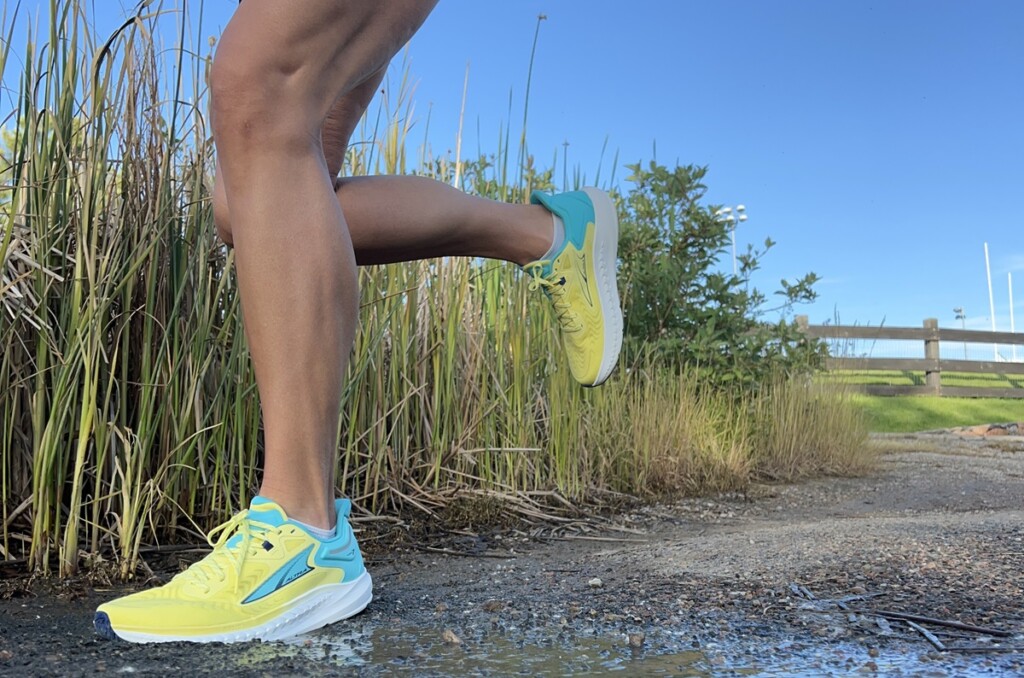 As a long time runner and running coach, I can tell you the data has shifted with more studies and better knowledge.
As a long time runner and running coach, I can tell you the data has shifted with more studies and better knowledge.
So what I want to share with you today is a better understanding of what your running foot strike means and most importantly what’s truly best for you.
It helps runners of all experience levels to understand good running form technique, and running up on your toes might be the opposite of heel striking, but that doesn’t mean it’s right.
Let’s talk more about what we mean by running foot strike and why heel striking may not be the worst thing ever, while forefoot running may have both advantages and disadvantages.
Understanding Running Foot Strike
Like I already said, I’m not here to tell you definitively how your feet should land when you run. There are simply too many variables involved and what’s right for one person is not necessarily right for all. Have you watched any of the elites run lately??? They have a lot of variation in their form to do what’s natural to them.
While, I really want to get you to stop overstriding and running on your toes to prevent some issues…well, we’ll get to that.
Think about this next section as a little bit of background knowledge we should all know about the different types of foot landings when running. We are not covering pronation while running, which is when your foot rolls in or out. This is just about where on your foot you land.
I’ve broken it in to 3 commonly discussed types, know that of course you could fall slightly between two types.
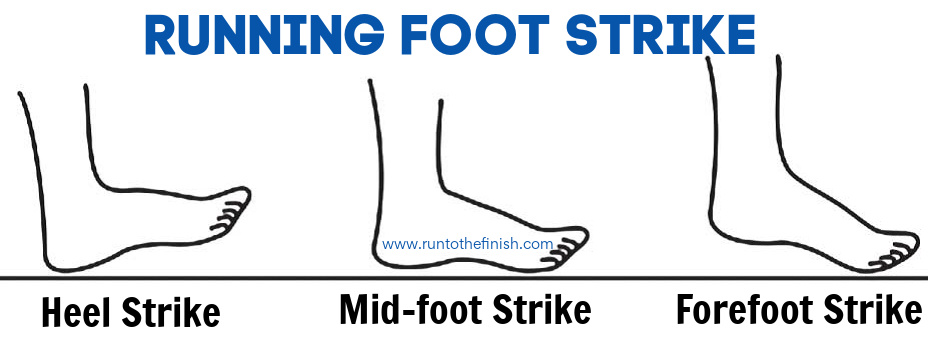
Heel Striking
When a runner lands heel first, that is known as heel striking. Simple enough. You may also hear this called the rearfoot strike.
Beyond landing heel first, another noticeable aspect of heel striking is a stride that reaches out ahead of where your body is, which is called overstriding. And overstriding is what we actually want to correct, not the heel strike itself in most cases.
This is probably the most common pattern among runners. While you will find many articles arguing that this form is inefficient or will most likely cause injuries, that is not necessarily true. More on that later.
Some benefits to heel striking include helping control your footing on a sharp turn or helping you slow down.
Midfoot Strike
Runners with a midfoot strike land closest to the center of the foot. The foot is almost flat to the ground upon landing. You may see this footstrike in marathon and other long distance runners, including elite athletes.
Some benefits to this pattern are that overstriding is practically impossible, runners may have a higher running cadence and feel that they absorb impact better.
I would also consider a midfoot strike when you land on the back end of the ball of the foot, which others would call forefoot running. I think that gets confusing and is what leads people to run too far up on their toes.
This tends to be the most recommended pattern for distance runners.
Forefoot Strike
Runners who have a forefoot strike tend to land on the ball of their foot or further forward on their toes. You may see this pattern in sprinters going shorter distances with a more pronounced forward lean.
With this foot strike pattern, overstriding is almost impossible. When running like this, it may feel light and fast, which is important for a sprinter. If you do some sprinting yourself, you may find you land with a forefoot strike.
However, for distance runners this is where we start to get in to trouble. If you’re landing up on the balls of your feet it means that your calf muscles are being engaged constantly. This leads to muscle cramps because they are being overworked.
How to Learn What Your Foot Strike Looks Like
There are several ways to figure out how you’re landing when you run. Having this information in your running toolkit may help you:
- Learn the best ways to improve form and efficiency
- Evaluate injury risk
- Determine recovery plans after an injury
- Pick the right footwear
Beyond simply paying attention to what part of your foot is landing first when out on your next run, probably the easiest way to determine your foot strike and also evaluate your form is to take a video.
If you have a treadmill, set up your phone to record your feet from behind and from the side, but don’t forget to get a full body view from different angles too. You can also easily do this outside or ask a fellow running friend to help.
One thing to remember is to continue running naturally when being filmed. Do not alter your cadence, gait, or footstrike in the moment. Maybe try to forget the filming is even happening.
I like to do a regular speed video and a slow motion video for each position to ensure we’re looking at all the details.
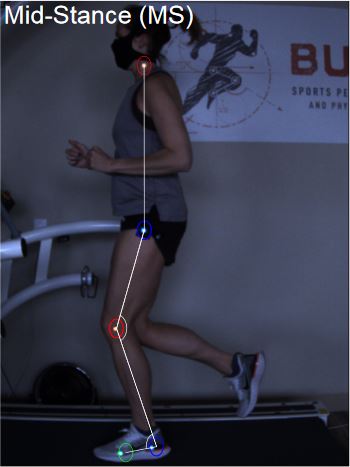
Remember that analyzing your gait is something professionals do, so you likely won’t pick up on everything at home.
It’s why I don’t recommend using the treadmill at a running store for a shoe analysis. Just because your foot is falling inward doesn’t mean you need a stability shoe. Quite often the issue is a weak glute that is allow your knee and ankle to fall inward.
Is Heel Striking Bad as a Runner?
Being a heelstriker is not necessarily a bad thing. A significant portion of runners are heel strikers (like over 90%), which means it’s simply the natural way in which they run.
It makes sense because in walking you land with your heel the push through the foot. In running, you’re trying to get the most power and so it naturally happens for many that way as well.
The commonly used arguments against heel striking when running are that it’s inefficient and leads to injury because of the load different parts of the body take on with each step. We all know that every time we take a step, our body has to absorb about 2 times our body weight.
That sounds like a lot and it is a lot, but changing our foot strike won’t change that. It may just change what parts of our body are absorbing
A 2014 study from Medicine and Sports Science Exercise, found “no clear overall mechanical advantage of a habitual [forefoot striking] or [rear foot striking]. Switching techniques may have different injury implications given the altered distribution in loading between joints but should be weighed against the overall effects on limb mechanics.”
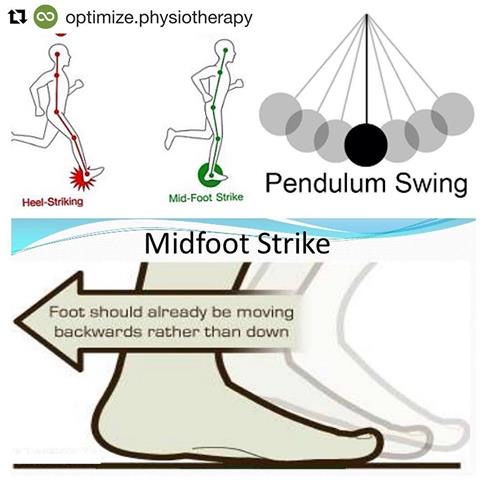
I like this graphic because it actually illustrates the CONFUSION so well!! This isn’t showing heel striking vs midfoot, but overstriding vs correctly landing under your body! The result of which might be a more midfoot strike or might still mean heel striking, but without the jolting force of landing in front of you.
What is Overstriding?
All right, so now we’ve determined that if you’re landing under the mid-line of your body with a heel strike it’s no big deal.
Overstriding is when your leg extends out in front of you and then you will almost definitely heel land heel first. This is when we do start to see some increase in injuries.
- Landing in front of the body with the heel is like a brake, sending a shock up the leg
- It’s likely slowing you down because it’s hard to have a forward lean in this position
- It’s super common when trying to run faster that we stretch out, instead of increasing our cadence
How to Fix Overstriding
Remember that each of us has our own unique mechanics and that will influence what’s ultimately “perfect” for our bodies. It’s also important to know that regardless of your foot strike type, good form is imperative to keeping you a healthy runner.
I’ve previously highlighted 4 easy tips to improve your running form. These include tips and details around why you need relaxed shoulders, tall posture, efficient arm movements (no crossing the body), and a short discussion on foot fall.
Here we’re going to talk specifically about your stride length and cadence, which often correct any issues with foot strike all by themselves.
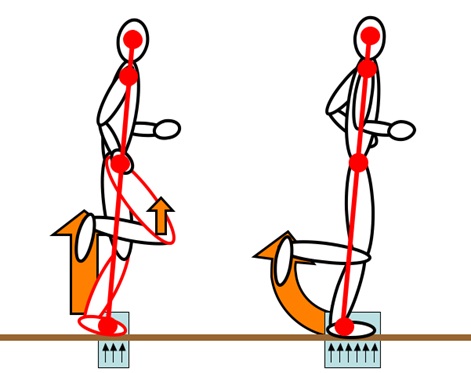
Regardless of whether you’re a rearfoot, midfoot, or forefoot runner, your feet should be landing beneath your torso and hips. You don’t want to be overstriding.
You can see why it’s very easy to conclude that heel striking when running is bad.
But, as we know, it’s not that simple (correlation isn’t causation as the saying goes) and studies are looking at this factor too when it comes to running mechanics.
- Increasing your cadence can help to get your foot landing under your body
- Practicing running form drills will create the neural pathways to make it more natural to land under the body
- Work on having a slight forward lean from the ankles, this will prevent you from leaning back and thus overstriding
- Include more uphill running workouts. These naturally force you in to good running form.
Should I Change My Foot Strike?
So, you’ve discovered that you’re a heel striker. You may be thinking, “Oh no! I need to change my foot strike.”
But as we’ve noted it may not be necessary. Let’s first look at the science and then talk more about overstriding, the real issue.
While many will argue there is one best way to run, science is finding other results.
A 2017 study in the Journal of Sport and Health Science looking at changing from a rearfoot strike to the supposedly more “optimal” mid- or forefoot strike found, “there is no obvious benefit to such a change for the majority of runners.” The authors go on to say that a change in foot strike may actually lead to other injuries a runner may not otherwise have incurred, which has been corroborated in other studies.
An earlier study from 2014 found similar results, but also found the following about rearfoot strikers trying to change to forefoot striking
- They had to produce 20% more work in legs when making the change
- They had an increase risk of injury to ankles and hips
- Forefoot strikers, in specific instances, may benefit from switching to a rearfoot strike
Runners with different foot strikes or who change how they land may find different parts of their body are stressed. Hip and knee joints tend to feel the impact the most for rearfoot runners, but what running-related injuries tend to occur for forefoot runners and midfoot runners?
Issues with Forefoot Running
Forefoot runners may see more injuries related to the ankle and Achilles tendon, or they may develop shin splints.
In fact, when runner tells me they are frequently dealing with calf cramps or pain I start by asking if they are running up on the balls of their feet. The common answer is “yes, I’m trying not to heel strike”. Unfortunately, what we know from the data is your calf muscles are then working overtime and more.
Of course there are many who say that you simply need to massage your legs and work through the pain. No, stop, this makes no sense.
If you’re running pain free, then forcibly change your gait and now have pain, something isn’t right.
Get off your toes, get closer to your midfoot or all your foot to simply hit naturally and work on the actual length of your stride.
So if you don’t need to change your footstrike, what can you do to ensure you’re running to the best of your abilities and remaining injury-free as much as possible?
Focus on your form!
Working On Overall Running Form
As you continue to grow and evolve as a runner, you may be looking at what you can do to continue to enjoy the sport, be injury-free as much as possible, and improve. At some point, if it hasn’t already, you may consider evaluating your form and your footstrike and making changes.
A 2015 study found that an individual’s running biomechanics play a role in injury development. It also found that there’s simply not enough evidence to suggest that modifying running form is necessary to lessen injury prevalence.
Keep the following in mind:
- We are all different biomechanically so what works for me or your best running buddy might not work well for you.
- There is no right or wrong way for your feet to land, but try not to overstride.
- Any changes you do make should be gradual and with the guidance of a coach or running-focused PT.
- Regardless of how your feet land, make sure you’re also tuned into what the rest of your body is doing and feeling.
- Oh, and do the warmup before you run!
In fact, you may find there are more benefits to focusing on your runner strength training goals than thinking about your foot strike! We know that the majority of injuries are actually the result of weak hips and glutes!
With that in mind a few more resources for you:
Other ways to connect with Amanda
Instagram Daily Fun: RunToTheFinish
Pinterest to find more Running Tips: RunToTheFinish
Facebook Community Chatter: RunToTheFinish
Sign Up to Receive a Weekly Newsletter with Top Running Tips and Laughs

